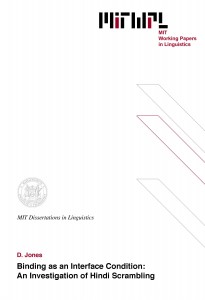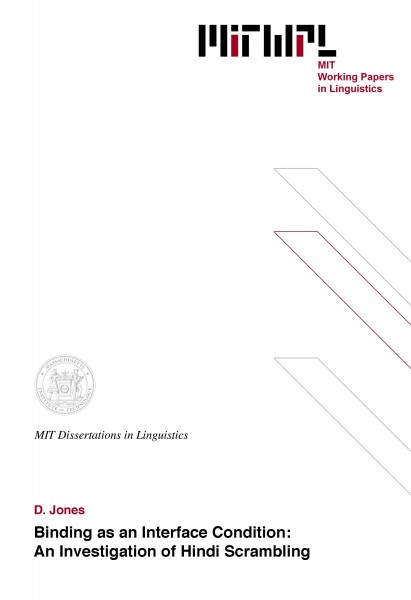Binding as an Interface Condition: An Investigation of Hindi Scrambling
D. Jones, 1993
This thesis provides an analysis of scrambling, following the Minimalist program of Chomsky 1992, examining Hindi as a case study and occasionally making comparisons with Japanese.
The first major claim is that there are two kinds of operations that yield scrambling. One type, called Outer scrambling, is an Operator-Variable construction and is the result of movement. The other type, called Inner scrambling, is the result of several conspiring factors that allow permutation without movement. These factors are triggered by (i) the strength feature of functional heads (ii) Economy principles that hold at phonological form and (iii) Full Interpretation, which causes the Agr structure to be deleted after its agreement relations have been established. These factors cause TnsP to collapse into an N-ary branching structure containing the arguments of the verb. It is assumed that linear order is not fixed until Spellout. Therefore, the N-ary branching structure is free to yield permutations without movement. Since there is no movement, and hence no trace of movement, Inner scrambling is not subject to reconstruction effects. Outer scrambling, since it is an Operator-Variable construction, is subject to reconstruction effects.
The second major claim is that the subject is special in that at least part of it must raise at LF to the Checking domain of C0. If the subject cannot be split, for example, when the subject is a monomorphemic pronoun, the entire subject must raise. The result is a novel solution to a problem for the Minimalist framework, namely, an account of how both Strong and Weak Crossover may be treated as interface conditions at Logical Form in scrambling constructions.
Furthermore, these structures are integral to an account which captures the subject-orientation of reflexive anaphors. The account also captures the lack of subject-orientation for reciprocal anaphors.
Thesis Supervisor: Noam Chomsky
Title: Institute Professor
Table of Contents
1 Introduction 9
1.1 Scrambling 9
1.1.1 Clause level scrambling 11
1.1.2 Clause external scrambling 13
1.1.3 Movement terminology 13
1.1.4 Copy theory of movement 14
1.1.5 Preference principle 15
1.1.6 Inert and active elements at head of chain 17
1.2 Theoretical issues for scrambling 20
1.2.1 Optionality and economy 20
1.2.2 Scrambling and parameters 25
1.3 Theoretical architecture 28
1.3.1 Binding relations are evaluated at the LF interface 29
1.3.2 Weak Crossover at LF 30
1.3.3 Strong Crossover at LF 31
1.3.4 Domains 31
1.4 Clause internal versus clause external scrambling 32
1.5 Fine-tuning of clause internal scrambling 34
2 Inner Scrambling by Clause Reduction 43
2.1 Strength of N and V features of Agr0 and Tns0 43
2.2 Clause reduction 44
2.3 Computational motivation for clause reduction 46
2.4 Specifiers and clause reduction 48
2.4.1 Spec identification 49
2.4.2 Chain identification and persistent identification 50
2.4.3 Definition of clause reduction 52
2.4.4 Radical clause reduction 55
2.4.5 Hierarchical clause reduction 58
2.4.6 Question of identifying IO 61
2.4.7 Arguments against AgrIO 61
2.5 Inner Scrambling – transitives and ditransitives 64
2.5.1 No inner scrambling at LF 65
2.6 Diagnostics applied to scrambling 65
2.6.1 Weak Crossover data 66
2.6.2 Strong Crossover data 67
2.6.3 Binding Condition C 69
2.6.4 Accounting for Strong Crossover 70
2.7 Reflexive binding 79
2.8 Subject raising to the checking domain of C0 at LF 88
3 Outer Scrambling by Operator-Variable Construction 91
3.1 Long distance scrambling of anaphors 91
3.1.1 Outer scrambling of reflexives 91
3.1.2 Outer scrambling of reciprocals 96
3.2 Interaction between inner and outer scrambling 97
4 Conclusion 110

